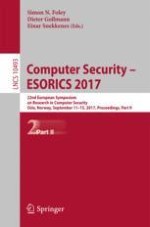2017 | Book
Computer Security – ESORICS 2017
22nd European Symposium on Research in Computer Security, Oslo, Norway, September 11-15, 2017, Proceedings, Part II
Editors: Simon N. Foley, Dieter Gollmann, Einar Snekkenes
Publisher: Springer International Publishing
Book Series : Lecture Notes in Computer Science
